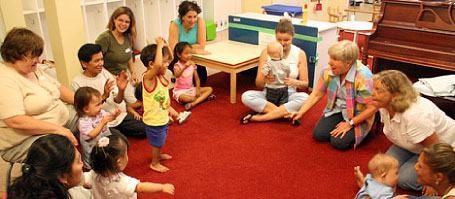
A guide to communicating with your child
Toronto Preschool Speech and Language Services: A community partnership designed to deliver speech and language services for infants, toddlers, and preschool children. This tip sheet tells you how most children learn to communicate and respond to language at different ages.
Babies (0-24 months) learn to communicate by listening to voices and sounds. A baby soon learns to make sounds to tell you how they feel or what they want. Babies develop at their own rate. Some babies do things at a young age; some will take a little longer.
Which language should I use with my child?
Many children grow up in homes where languages other than English (or French) are spoken. Parents often wonder which language they should use with their child. The research shows that it is important to maintain family and cultural connections with the child’s home language. Therefore, parents should use the language or combination of
languages that they would typically use at home.
If your child’s first language is not English, please use the suggestions in this brochure in the home language of your child.
When determining whether your child has a speech and/or language delay, your child’s skills in their first language should be used.
BY SIX MONTHS
Does your child:
- startle in response to loud noises?
- turn to where a sound is coming from?
- make different cries for different needs (hungry, tired)?
- watch your face as you talk to her/him?
- smile/laugh in response to your smiles and laughs?
- imitate coughs or other sounds such as ah, eh, buh?
Call for help if your baby
- Does not react to your voice or other sounds.
- Does not smile or make sounds when awake.
- Does not seem to enjoy interacting with you
- Does not look at you or try to get your attention
What you can do:
- Pause in the middle of a song. Watch for your baby to ask for more; finish singing the song.
- Name objects your baby touches or looks at (“Oh, a diaper. You’ve got the diaper.”).
- Shake noise makers in front of your baby, then stop. See if your baby asks for more by looking for it or by imitating the action. Then shake it again.
- Sing lots of songs or nursery rhymes (Peek-a-Boo, Pat-a-Cake, Up & Down, tickle games).
- Talk to your baby when you are washing, dressing or feeding them.
- Use gestures with your words (eg. hands up when saying “up”)
- During bath time, name each body part as you wash it. Play games like “This Little Piggy Went to Market”; “Head and Shoulders, Knees, and Toes”.
- Put a favourite toy in front of your baby just out of reach. Wait and see how they show you they want it.
- Show your baby picture books and talk about what you see.
- Make fun sounds with your baby, like “shhhh”, “boom”, “uh oh” and animal sounds
- Exaggerate your facial expressions and tone of voice
- Get down on the floor and play with your baby
BY 12 MONTHS
Does your child:
- follow simple one-step directions (sit down)?
- look across the room to a toy when adult points at it?
- consistently use three to five words?
- use gestures to communicate (waves hi/bye, shakes head for no)?
- get your attention using sounds, gestures and pointing while looking at your eyes?
- bring you toys to show you?
- perform for social attention and praise?
- combine lots of sounds together as though talking (abada baduh abee)
- show an interest in simple picture books?
Call for help if your child
- Does not make sounds or babble.
- Does not show interest in you or other people.
- Does not actively take turns in familiar games with adults (handing something back and forth, knocking down stacked blocks, dumping out containers, banging on pots).
- Does not try to show you things by looking or reaching.
What you can do
- Talk about things you see and what people are doing during the day and as you look at books.
- During everyday activities, talk about what you are doing using short sentences.
- Name pieces of clothing and body parts for your child (“shoe off”, “hat on”).
- Play: “Where did you go?” when putting clothing over your child’s head.
- Sing simple songs with actions. Help your child to copy your actions and sounds (“Ring Around the Rosie”, “Row, Row, Row Your Boat”).
- Sing children’s songs in the language that you use at home.
- Talk in short sentences (“Want some milk?” or “Whoops! Fall down”. “Oh, baby is crying.”).
- Play Peek-a-Boo by taking turns hiding behind your hands, a towel or blanket. Move it away saying: “Where’s Daddy?, Here I am,” or “Peek-a-Boo.”
BY 18 MONTHS
Does your child:
- understand the meaning of in and out, off and on?
- point to several body parts when asked?
- use at least 20 words consistently?
- respond with words or gestures to simple questions (Where’s teddy? What’s that?)
- demonstrate some pretend play with toys (gives teddy bear a drink, pretends a bowl is a hat)?
- make at least four different consonant sounds (p ,b, m, n, d, g, w, h)?
- enjoy being read to and sharing simple books with you?
- point to pictures using one finger?
Call for help if your child
- Is not trying to talk.
- Does not make gestures or sounds.
- Started to use words, but stopped.
What you can do:
- Take turns with your child. Bang on pots and pans, blow bubbles, push toy cars and trains, feed the baby doll.
- Get down and play like your child does.
- Use action words like “roll ball,” “drink milk,” “wash hands”
- Go for a walk. Talk about what is happening.
- Show your child picture books and talk about what you see. Remember that you can make up words to the story and read to your child in the language you use at home.
- Visit places like the grocery store, Early Years Centre, library, and zoo and use these trips to teach your child new words
BY TWO YEARS
Does your child:
- follow two-step directions (Go find your teddy bear and show it to Grandma.)?
- use 100 to 150 words?
- use at least two pronouns (you, me, mine)?
- consistently combine two to four words in short phrases (Daddy hat. Truck go down.)?
- enjoy being around other children?
- begin to offer toys to other children and imitate their actions and words?
- use words that are understood by others 50 to 60 per cent of the time?
- form words or sounds easily and without effort?
- hold books the right way up and turn the pages?
- read to stuffed animals or toys?
- scribble with crayons?
Call for help if your child
- Lacks awareness or interest in others.
- Cannot be understood by you at least half the time
- Does not put two words together.
- Does not use a variety of words (actions, descriptors, locations, etc)
- Stutters
What you can do
- Take your child to an Early Years Centre, a library, and/or other places with fun programs for children.
- Take turns tickling, feeding, and rocking dolls or teddy bears.
- Sing simple songs with actions (Eensy Weensy Spider, Round and Round the Garden).
- Repeat back what your child is trying to say with the correct grammar (Child: “Mommy work.” Adult: “Yes. Mommy is at work.”).
- Talk about what you are doing during daily activities.
- Use two to four word sentences when talking (“Look up! I see a cat.”)
- Expand your child’s world by introducing new people and new places. Talk about the experience before you go, while you are there and when you get home.
- Hide objects under/behind pillows, blankets, furniture. Ask: “Where’s the ball?” or “Find the teddy.”
- Point to and talk about people and things when looking at books
- Remember to tell stories from your home language and culture.
- Look at your child when you are talking to each other.
Between the ages of two and four years a child’s speech and language develops quickly. The number of words they can say increases rapidly and they put together longer and longer sentences. They begin to ask many questions during their everyday activities. They enjoy listening to stories and music. Often they will ask you to read the same story over
and over again. Sometimes they will remember the words in the stories so well, it will seem like they can almost read.
BY THREE YEARS
Does your child:
- understand who, what, where and why questions?
- create long sentences using five to eight words?
- talk about past events (trip to grandparents house, day at child care)?
- tell simple stories?
- show affection for favourite playmates?
- engage in multi-step pretend play (pretending to cook a meal, repair a car)?
- talk in a way that most people outside of the family understand what she/he is saying most of the time?
- have an understanding of the function of print (menus, lists, signs)?
- show interest in, and awareness of, rhyming words?
Call for help if your child
- Acts frustrated when trying to communicate.,
- Does not put more than three words together.
- Does not seem to understand what you are saying.
- Is not understood most of the time by others.
- Stutters
What you can do
- Describe things that are happening using sentences (“I’m really HUNGRY. That’s a HUGE bite.”).
- Talk about how things are the same or different.
- Arrange times for your child to play with other children his/her own age.
- Repeat what your child says using correct sounds and sentences (Child: “Me want doose.” Adult: “I want juice too. I like juice!”).
- Play games together.
- Add information to what your child says (Child: “There are flowers” Adult: “That’s a daffodil and a tulip. They grow in the spring.”).
- Ask your child to be a helper and give them small jobs to do.
- Read books with pictures and take turns telling little stories about the pictures.
- Play make-believe with or without toys (pretend to go shopping, dress-up, play with pretend toy garages/kitchen sets,).
- Sort pieces of clothing together while doing laundry (sort by colours, who they belong to, where they go, type of clothing).
BY FOUR YEARS
Does your child:
- follow directions involving three or more steps (First get some paper, then draw a picture and give it to Mommy.)?
- tell stories with a beginning, middle and end?
- try to solve problems with adults and with other children using words?
- show increasingly complex imaginary play?
- talk in a way that he/she is understood by strangers almost all the time?
- generate simple rhymes (cat-bat)?
- match some letters with their sounds (letter b says buh, letter t says tuh)?
Call for help if your child
- Is not understood almost all the time by others.
- Does not use complete sentences.
- Stutters.
What you can do:
- Talk about what you and your child are doing/interested in.
- Play simple board games/card games helping them to match and name colours/shapes, count, and follow directions (Snakes & Ladders, Go Fish).
- Repeat clearly words and sentences your child has difficulty saying (Child: “Him “wunning” outside.” Adult: “Yes, he is. He is running outside.”).
- Let your child make up and tell stories using puppets, toys, objects, books or pictures
- Read longer stories to your child.
- Give your child opportunities to regularly play with children his/her own age.
This material has been adapted from First Words (Ottawa-Carleton Preschool Speech and Language Service) and The Language Express (Preschool Speech and Language Services System of Lanark, Leeds and Grenville).
For Help
For help call the Central Referral and
Information Line
416-338-8255
416-338-0025 (TTY)
Or call your local Quadrant
East Quadrant 416-281-7445
Rouge Valley Health System Centenary Site
North Quadrant 416-491-1230
North York General Hospital
South Quadrant 416-921-4498
The Hanen Centre
West Quadrant 416-622-8315
The George Hull Centre
French Language 416-491-1230
Services (En Français)
North York General Hospital




